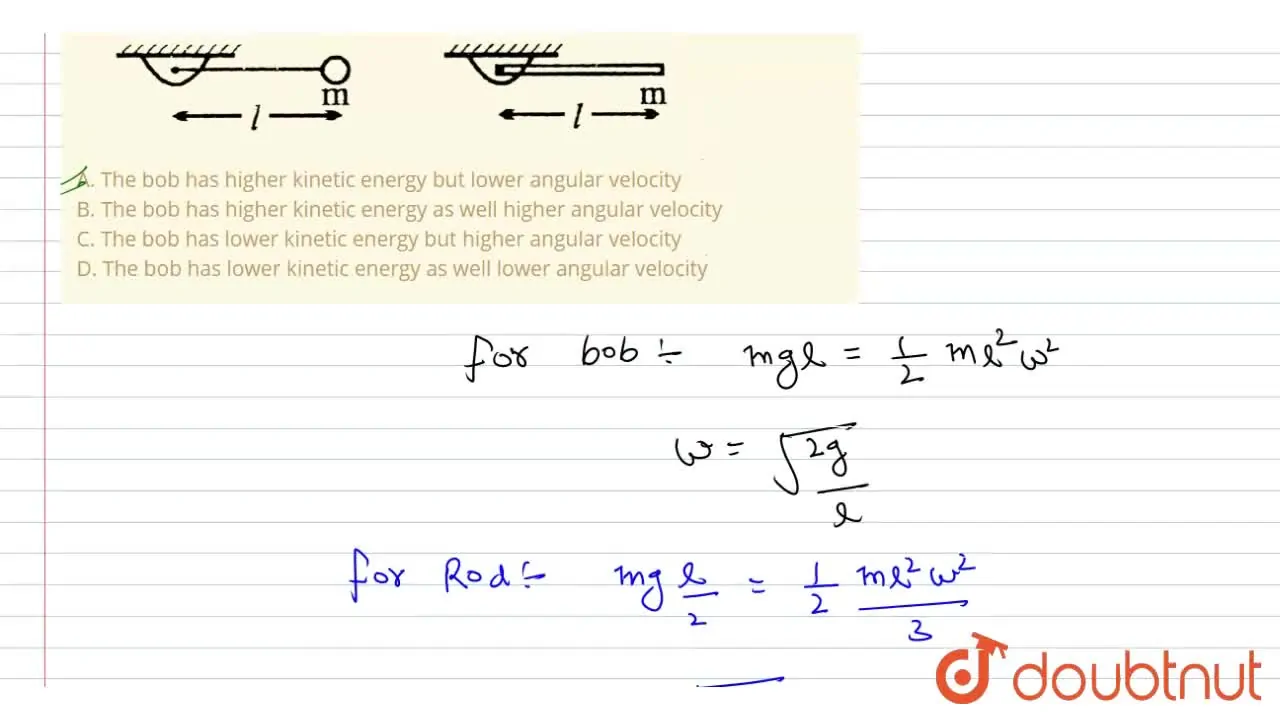In the 1st figure shown here rod is massless and at its end a bob of mass m is attached. The other figure is a uniform rod also of mass m. As they are released, at the bottom

A. The bob has higher kinetic energy but lower angular velocity
B. The bob has higher kinetic energy as well higher angular velocity
C. The bob has lower kinetic energy but higher angular velocity
D. The bob has lower kinetic energy as well lower angular velocity
The bob has higher kinetic energy but lower angular velocity
The bob has higher kinetic energy as well higher angular velocity
The bob has lower kinetic energy but higher angular velocity
The bob has lower kinetic energy as well lower angular velocity
(i) τnet=PEsin53∘=Iα
∴α=(ql)E(45)ml212+m(l2)2+m(l2)2=48qE35ml
(ii) From energy conservation : Ki+Ui=Kf+Uf
∴0+(−PEcos53∘)=12Iω2+(−PEcos0∘)
where I=ml212+m(l2)2+m(l2)2=7ml212 ∴ 12Iω2=PE(1−3/5)=25PE
∴12×7ml212×ω2=25 qlE or ω=√48qE35ml
(iii) ∵Wext=Uf−Ui
∴Wext=(−PEcos(180∘+53∘))−(−PEcos53∘)
or Wext=(ql)E(35)+(ql)E(35) ⇒ Wext=(65)qlE
Related Playlists
- BOOK - RESONANCE ENGLISHCHAPTER - ELECTROSTATICSEXERCISE - Problems22videos
ELECTROSTATICS
- BOOK - RESONANCE ENGLISHCHAPTER - ELECTROSTATICSEXERCISE - Exercise-1 Section (A)9videos
ELECTROSTATICS
- BOOK - RESONANCE ENGLISHCHAPTER - ELECTROMAGNETIC INDUCTIONEXERCISE - A.l.P19videos
ELECTROMAGNETIC INDUCTION
- BOOK - RESONANCE ENGLISHCHAPTER - EXPERIMENTAL PHYSICSEXERCISE - PART -II10videos
EXPERIMENTAL PHYSICS
Similar Questions
which has higher 1st ionisation energy B or Be and why?
View SolutionAn electron and a photon have the same de Broglie wavelength. Which one of these has higher kinetic energy?
View SolutionA rod of mass m spins with an angular speed ω=√gl, Find its a. kinetic energy of rotation. b. kinetic energy of translation c. total kinetic energy.
 View Solution
View SolutionA metal wire of length L is suspended vertically from a rigid support. When a bob of mass M is attached to the lower end of wire, the elongation of the wire is l:
View Solution
System is shown in the figure. Velocity of sphere A is 9 ms. Find the speed of sphere B.View SolutionWhen electron falls from a higher energy to a lower energy level the difference in the energies appears in the form of
View SolutionA particle of mass m has momentum p. Its kinetic energy will be
View SolutionThe movement of energy from lower to higher trophic level is
View SolutionA car is travelling at a velocity of 10 m/s and has a mass of 850 kg. What is its kinetic energy?
View SolutionA gun of mass M fires a bullet of mass m, with a Kinetic energy E. The total kinetic energy in the firing process is
View Solution


